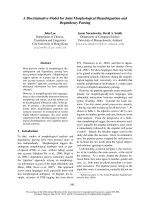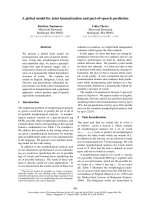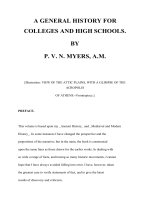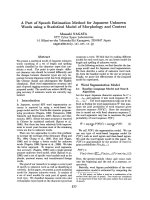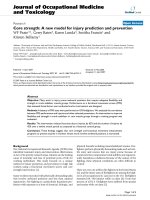A QUALITY MODEL FOR STEM AND STEAM SCHOOLS
Bạn đang xem bản rút gọn của tài liệu. Xem và tải ngay bản đầy đủ của tài liệu tại đây (553.07 KB, 22 trang )
<span class="text_page_counter">Trang 1</span><div class="page_container" data-page="1">
A Quality Model for
STEM and STEAM Schools
RECOMMENDATIONS FROM THE STEM INNOVATION WORKING GROUP
OHIO DEPARTMENT OF EDUCATION OFFICE OF INNOVATION
</div><span class="text_page_counter">Trang 2</span><div class="page_container" data-page="2">Foreword
Future economic growth and prosperity in Ohio depends on an aligned education system that supports the state’s economic development efforts and helps all Ohio students to become innovators and inventors, self‐reliant and logical thinkers, and technologically proficient problem solvers. In 2007, Ohio enacted legislation to create STEM schools, an initiative designed to better align education systems to ensure sufficient intellectual, entrepreneurial, and technical talent for Ohio’s future economic development. As 2017 marks the 10-year anniversary of this legislation, in the fall of 2016 the Ohio Department of Education Office of Innovation convened an informal STEM Innovation Working Group, to build upon ideas for next steps in STEM education in Ohio.
The primary purpose of the STEM Innovation Working Group, made up of individuals and organizations who support STEM education in some capacity, is to assist the Office of Innovation in identifying where gaps in student readiness and teacher professional development may still exist, and in identifying priorities and common goals for STEM education. Feedback from the working group is presented to the STEM Committee, who authorizes STEM designation for approved schools in Ohio.
Goals, priorities and possible strategies identified in early conversations with the STEM
<i>Innovation Working Group are presented in the chart A Vision for Next Generation </i>
<i>STEM Innovation in Ohio, that follows. The working group identified the need for a </i>
quality metric for STEM schools, to ensure quality programming that promotes innovation and preserves the integrity of Ohio’s goals for STEM education. Over the course of the 2016-2017 school year, the Office of Innovation met with the working group to collect feedback regarding the essential criteria for high quality STEM schools and programs. These criteria and associated discussions formed the foundation for this document.
</div><span class="text_page_counter">Trang 3</span><div class="page_container" data-page="3"><b>A Vision for Next Generation STEM Innovation in Ohio </b>
<b>Vision: Ohio will be recognized as a leading state in having a well-qualified workforce to attract STEM-related investments in business and industry. Mission: To create and promote initiatives that will pave the way for growth and economic development in Ohio, through multi-sector partnerships for </b>
STEM-related learning experiences for Ohio’s students.
<b>Alignment </b>
<i>Align STEM Education efforts to regional economic development needs, emphasizing innovation and entrepreneurship. </i>
• In PK-12 STEM education, enhance the voice of Industry, Higher Ed and other agencies, by increasing the degree of collaborative, active engagement in the preparation of Ohio’s future STEM workforce.
• Increase alignment of STEM educational programs to state and regional industry needs. • Increase emphasis and student participation in learning opportunities that focus on computer science.
<b>Accessibility </b>
<i>Work to ensure that all students in Ohio have access to a high-quality STEM education, and promote STEM literacy for ALL students. </i>
• Increase STEM designation participation, especially in Northwest and Southeast Ohio, and in rural or small districts.
• Increase student participation in authentic mentorship, internship and research opportunities in STEM, especially for underserved students and students in rural and small districts.
• Decrease barriers to STEM designation and STEM literacy.
• Increase accessibility to highly qualified educators knowledgeable in STEM subjects, especially for underserved students and in rural and small districts.
<b>Advocacy </b>
<i>Leverage and enhance existing networks to increase awareness and participation in quality STEM opportunities for students, educators and families. </i>
• Collaborate with other state agencies, organizations, industry and local advocates to increase awareness of opportunities for students, educators and families to engage in STEM-related activities.
• Increase awareness of various pathways to STEM careers available to students, including 4-year and advanced degrees, 2-year degrees, certificates and apprenticeships.
• Increase awareness of the benefits of STEM literacy for all students.
• Increase awareness of the benefits of STEM as a vehicle for deeper learning.
<i>Work collaboratively with the STEM Committee, the Ohio STEM Learning Network, higher education and other public and private partners to develop a long term plan for “next generation” STEM Innovation in Ohio. </i>
• Create a STEM working group, to provide feedback to the department of education regarding greatest achievements and greatest challenges for STEM education in Ohio. Utilize feedback to drive improvement efforts.
• Examine alignment of STEM educational programs to state and regional industry needs, and make recommendations for improvement. • Identify key indicators and pre-existing metrics
and use them to monitor progress toward goals. • Utilize and enhance existing partnerships to
<b>Pathways </b>
<i>Identify and promote various pathways to STEM careers available to students, and develop a metric for recognizing quality pathways and programs. </i>
• Create/identify and promote STEM career pathways leading to 4-year and advanced degrees, 2-year degrees, certificates, and apprenticeships that promote the application of cutting-edge technology and the growth of innovative new industry in Ohio.
• Consider an elementary designation. • Create metrics and programs for recognizing
quality and level of immersion in STEM for schools, pathways, and programs, to
<b>Preparedness </b>
<i>Work collaboratively with higher education, ESCs, and other partners to provide support for teacher recruitment and preparation for teaching STEM subjects. </i>
• Define and approve “high quality” teacher licensure programs and pathways for STEM educators. • Create/identify and promote externship programs
with industry partners for teachers and leaders to experience content as it is applied in industry and to engage in industry research and development projects.
• Utilize teacher-leader networks, local advocates, and peer-to-peer role models in providing local professional development and support for STEM educators.
• Provide focused professional development
</div><span class="text_page_counter">Trang 4</span><div class="page_container" data-page="4">Acknowledgements
The Office of Innovation would especially like to thank the following members of the STEM Innovation Working Group for their significant contributions in drafting, refining, and revising the text for this document:
Jennifer Domo, Director, SCOPES Academy, Unioto Elementary School
Dr. Andrew Dougherty, Research Scientist, The Ohio State University Department of Physics
Jeanne Gogolski, Education Specialist, Ohio Soybean Council
Kirk Koennecke, Superintendent, Graham Local Schools
Angela McMurry, President, Science Education Council of Ohio
Dustin Pyles, STEM Consultant and Grant Manager, Vaza Consulting, LLC
Marcy Raymond, Director of STEM Initiatives, Educational Service Center of Central Ohio
Heather Sherman, Manager, STEM Schools and Community Partnerships, Battelle Education
Dr. Sheli Smith, Chief Academic Officer, The PAST Foundation
Tamee Tucker, Chief Academic Officer, iSTEM Geauga Early College High School
Dr. Missi Zender-Sakach, Science, Health and Physical Education Consultant, Summit Educational Service Center
Other STEM Innovation Working Group members who contributed to the Quality Model:
Cassie Barlow, Ph.D., Director, Aerospace Professional Development, Southwestern Ohio Council on Higher Education
Erin Bender, J.D., Executive Director, STEAM Innovation Center, Otterbein University
David Burns, Director, Battelle STEM Innovation Networks, Battelle Education
Lisa Chambers, National Executive Director, TechCorps
Brian Coffey, Principal, Baldwin Road Junior High STEM School, Reynoldsburg City Schools
Dr. Annalies Corbin, President and CEO, The PAST Foundation
Kevin Cornell, STEM Consultant and CEO, Mr. C, LLC
Kerry Dixon, Ph.D., Executive Director, Beta by Design
Meg Draeger, STEMM Coordinator, Chaminade Julienne Catholic High School
Dr. David Estrop, CEO, Estrop Consulting, LLC
Robin Fisher, Superintendent and Chief Academic Officer, Dayton Regional STEM School
Trudy Giasi, STEM Special Projects Coordinator, Columbus City Schools
Brenda Haas, Ed.D., Associate Vice-Chancellor, P16, Ohio Department of Higher Education
Kathy Harper, Ph.D., Senior Lecturer, The Ohio State University Department of Engineering Education
Josh Jennings, Founding Director, Global Impact STEM Academy
</div><span class="text_page_counter">Trang 5</span><div class="page_container" data-page="5">Stephanie Johnson, Ed.D., MPH, PMP, Relationship Manager, Education, STEM Learning and Philanthropy, Battelle Education
Rachel Kajfez, Ph.D., Assistant Professor, The Ohio State University Department of Engineering Education
Aimee Kennedy, Ph.D., Senior Vice President, Philanthropy and Education, Battelle Education
Kim Kiehl, Ph.D., Director, Museum of Ohio Project, Ohio History Connection
Stephanie Lammlein, Chief Administrative Officer, Bio-Med Science Academy STEM School
Jeff Layton, Superintendent, Northwestern Local Schools
Tracy Martz, Director of STEM Initiatives, Dayton Early College Academy
Meka Pace, Executive Director, The Metro School
Ketal Patel, School Design and Strategy, The PAST Foundation
Merideth Sellers, Assistant Professor, Department of Biological and Physical Sciences, Columbus State Community College
Jayshree Shah, Founding Director, Tri-State Early College STEM School
Kim Shepherd, Elementary Principal, New Hope Christian Academy
Jeremy Shorr, Director of Technology Innovation, Teaching Institute for Excellence in STEM
Tim Sisson, K-12 STEM Content Manager, Cleveland Metropolitan School District
Susan Stearns, Assistant Director of Programming and Development, Northwest Ohio Center for Excellence in STEM Education
Dr. James Tomlin, Associate Dean, College of Education and Human Services, Wright State University
Chad Watchorn, Executive Director, Dayton Regional STEM Collaborative
Mike Woytek, CEO, The Ohio Academy of Science
Andrea Zaph, Health Academy Director, Patient Care/Medical Laboratory Technician Program Director, Collins Career Technical Center
Ohio Department of Education Office of Innovation:
Buddy Harris, Director
Holly Lavender, STEM Education Lead
</div><span class="text_page_counter">Trang 6</span><div class="page_container" data-page="6">Domain I. A Culture of Learning – Beliefs and Dispositions, Equity and Access ... 11
Domain II. Learning and Teaching ... 14
Domain III. Pathways to Success ... 18
References Consulted ... 20
Appendix - Summary Tool for School Self Evaluation ... 21
</div><span class="text_page_counter">Trang 7</span><div class="page_container" data-page="7">Introduction
The purpose of the Quality Model is to promote innovation and to assist schools in aspiring toward high quality STEM and STEAM implementation at the local level. The Quality Model is also intended to provide clarity for schools applying for STEM or STEAM designation. Drawing from research studies of inclusive STEM schools, STEM school guidance documents from other states, and additional resources, the STEM Innovation Working Group identified twelve criteria as essential for producing the desired outcomes, as shown in the Logic Model on the following page. These criteria have been organized into three overarching domains: School Culture and Beliefs, Learning and Teaching, and Pathways to Success in Careers. A summary is included on page 9, followed by elaboration for each essential criterion. The elaboration for each criterion is designed to provide a description along with clarifying points. Schools should note that the bulleted points are not intended to be a checklist or to imply that a school must be doing everything listed to be considered for STEM or STEAM designation. Rather, the bulleted points are included simply to provide clarification and examples, to assist schools in visualizing what high quality STEM or STEAM implementation can look like.
It is the view of the Department and the STEM Innovation Working Group that there is no “one right way” of designing and implementing high-quality STEM or STEAM programming. A good program will reflect community values and the unique culture of the school, which will vary depending on the local context. Additional resources with guidance around best practices are available on the Department’s STEM web page, at
</div><span class="text_page_counter">Trang 8</span><div class="page_container" data-page="8"><i><small>Acknowledgements: Great Lakes College and Career Pathways Partnership; George Washington University OSPrI study </small></i>
</div><span class="text_page_counter">Trang 9</span><div class="page_container" data-page="9">Central to STEM and STEAM schools is an instructional model that includes an innovative, integrated curriculum with multiple opportunities for students to engage in authentic, problem-based learning and design thinking. STEM- and STEAM-designated schools must demonstrate an integrated curriculum that is project-based. Schools aspiring toward this innovative
instructional model should consider both the depth and breadth of integration, as exemplified in the below continua for transformation to authentic problem-based learning and level of STEM
integration. At the deepest level,
<i>project-based learning is embedded </i>
in authentic problem-based learning opportunities that are
transdisciplinary, transcend school walls, and address issues relevant to the global or local community and the student. When deeply
implemented, problem-based learning serves to define the school’s instructional model – as opposed to occasional projects implemented by a few teachers.
For schools aspiring toward STEM or STEAM designation, breadth of integration is also essential. This diagram points out an important difference between
<i>a STEM program and a STEM school. In a STEM or </i>
STEAM school, STEM is broadly integrated into all subjects throughout the school. In a STEAM school, the arts and design are also integrated into science, technology, engineering and math to catalyze STEM
learning.
How to Use this Document
Schools are encouraged to use the included descriptions and bulleted points, in conjunction with other resources, as the basis of local discussion and professional development around school transformation and innovation. Space for notes is included with each criterion. A summary tool is included as an Appendix, should schools wish to use the Quality Model for self-evaluation.
Schools are reminded that the bulleted points should not be used as a checklist, but are intended to assist schools in visualizing what high quality STEM or STEAM implementation can look like. Currently designated STEM schools and aspiring STEM schools alike can benefit from focused professional development aligned with the essential criteria.
</div><span class="text_page_counter">Trang 10</span><div class="page_container" data-page="10">Overview
<b>Essential Criteria for High Quality STEM and STEAM Implementation Domain I. A Culture of Learning – Beliefs and Dispositions, Equity and Access </b>
<i>STEM and STEAM Schools exhibit: </i>
1. cultural strategies that reflect innovation, an entrepreneurial spirit, inquiry, and collaboration with individual accountability.
2. an inclusive mission that supports ALL students. 3. opportunities for personalized learning.
4. flexible and autonomous leadership that communicates a shared vision, and that supports innovative instruction.
<b>Domain II. Learning and Teaching </b>
<i>STEM and STEAM Schools exhibit: </i>
5. learning that prepares ALL students for college and careers in STEM, and that preserves disciplinary and interdisciplinary integrity.
6. authentic, problem-based learning and design thinking. 7. an integrated, innovative curriculum.
8. dynamic assessment systems that include authentic, performance-based assessments.
9. a well-prepared teaching staff, with ongoing and personalized professional learning.
<b>Domain III. Pathways to Success in Careers </b>
<i>STEM and STEAM Schools exhibit: </i>
10. curricular connections with business and industry, providing opportunities and access for success in college and career.
11. STEM-rich formal and informal experiences with the community that are personally relevant to the student.
12. collaborative partnerships with business, industry, arts, and higher education that provide and enhance opportunities for practical and real-world experience.
</div><span class="text_page_counter">Trang 11</span><div class="page_container" data-page="11">Domain I. A Culture of Learning – Beliefs and Dispositions, Equity and Access
<i><b>Essential Criterion1: STEM and STEAM schools exhibit cultural strategies that reflect </b></i>
<i>innovation, an entrepreneurial spirit, inquiry, and collaboration with individual accountability. </i>
<b>Cultural Strategies - Cultural strategies reflect a community’s understanding of success. Community </b>
needs drive instructional and delivery strategies in each school. Habits of Mind reflect what a community values in a successful adult, and are explicitly taught and continually utilized within the school.
<b>Habits of Mind reflect what a community values and explicitly teaches. Innovation - and risk-taking are encouraged on an ongoing basis, through: </b>
honoring all ideas and input. design thinking.
empowering to instill responsibility and accountability.
providing opportunities to demonstrate learning (e.g., student exhibits on-site, online, in state and national forums, etc.).
<b>An Entrepreneurial Spirit - is valued and encouraged, through: </b>
developing a shared mission and vision for creating new processes, products, or ideas. establishing partnerships with higher education, local business/industry and community input. sharing new processes, products, or ideas within the community.
<b>Inquiry - is valued and encouraged through: </b>
encouraging an inclusive culture of creativity and exploration.
facilitating student-driven investigations rather than teacher-driven learning.
<b>Collaboration and Communication - are valued and encouraged through: </b>
community partners as peers in the learning process. teamwork.
opportunities for authentic presentations.
<b>Individual Accountability - is demonstrated by students: </b>
<i> persevering through academic and non-academic challenges. understanding that setbacks are opportunities for growth. understanding that practice improves performance. </i>

